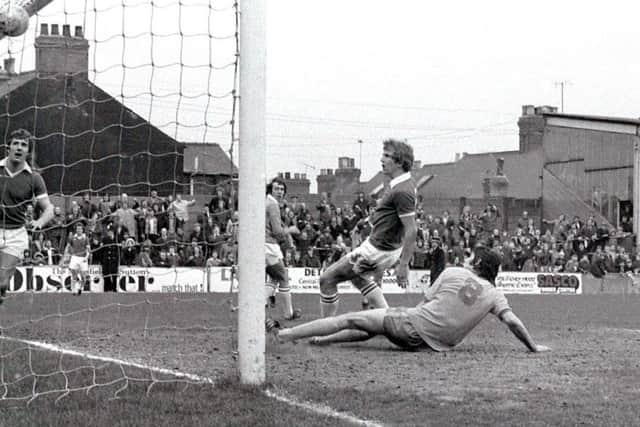OPINION: Football's concussion crisis - the cautionary tale of Ernie Moss and why the FA must act now


It is necessary, for example, for the woodpecker to thrust its head towards the hard bark of trees; Its third inner eyelid prevents the woodpecker’s eyeball from being ejected out of the skull as the bird pecks with a force of 1000Gs.
The brain of the woodpecker is also highly evolved. Rather than being surrounded by the thin layer of cerebrospinal fluid, allowing the brain to rattle around during impacts, as in humans, the woodpecker’s brain is enveloped by mesh of thick, spongy bone. This mesh acts as armour plating for the woodpecker’s brain, protecting against injury.
Advertisement
Hide AdAdvertisement
Hide AdFootballers are unfortunately without these safety mechanisms.


Is it possible that the repeated impacts to the head involved in football - the heading of footballs, and the often sickening head-to-head collisions with opponents of playing football - could lead to brain injuries?
Brain injuries in footballers are yet to be rigorously studied.
More evidence on generation of brain injuries in boxers and American footballers has been gathered however, and the horrific experiences of these groups may be instructive.
Advertisement
Hide AdAdvertisement
Hide AdIn the latter, the repeated mild traumatic brain injuries sustained by players of their careers have been linked to myriad health problems.


Former Pittsburgh Steeler, and NFL Hall-of-Famer Mike Webster provides a chilling case study for football fans in the UK.
Webster’s mental health decline, including depression, the breakdown of his marriage, and financial ruin, was caused, according to Webster, by the toll of repeated blows to the head whilst manning the NFL’s trenches for over a decade.
Does football need to heed these warning signs?
There are some important differences between the two sports.
Advertisement
Hide AdAdvertisement
Hide AdIn American football, the head is often used as both a weapon and a target. Defenders, commonly weighing upwards of 18 stones and capable of moving up to 25mph, use their helmets to spear into opponents inflicting damage and jarring the ball loose.
Offensive players, in order to secure the ball, and ironically in an attempt to protect themselves, often lower their heads, creating bone-jarring helmet to helmet collisions. Obviously this does not occur in football.
However, mild traumatic brain injuries can be incurred in many ways. Head to head collisions occur as players contest crosses. And the repeated impact of heading footballs could create mild trauma - more so in the in the days of heavy wet leather footballs.
Which brings us to the unfortunate story of Ernie Moss.
Moss was an unheralded prospect as a youth player in the Chesterfield area, but through sheer force of will this gentle giant was able to make his mark. Moss left school and worked as an office cork for the local council, with a career in professional football seeming as far away as ever.
Advertisement
Hide AdAdvertisement
Hide AdMoss continued to turn out for local non-professional sides alongside his day job, and continued to hone the skill that would set him apart from more technically accomplished peers. His first professional manager described his lack of technical ability thus: “His balance was nil, therefore his ball control was nil. He knew where the goal lay but he couldn’t often hit it”.
It didn’t matter. Ernie knew what he had one advantage, and made it pay, forging a career centred on his hulking frame and powerful aerial ability. Rather than scurry around improving his footwork in the search for goals, Ernie stuck to what he did best - craning around and over defenders to head the ball home.
Thousands of training sessions, and 245 Football League goals later the gentle giant hung up his boots.
The goals appear to have come at a price, however. Moss now suffers from Pick’s disease, a neurodegenerative disease that involves the destruction of nerve cells in the brain. Symptoms of this destruction includes behavioural changes, language difficulties, severe anxiety and a loss of social skills.
Advertisement
Hide AdAdvertisement
Hide AdNo link has yet been established between the repeated blows to the skull which may occur in football and subsequent brain degenerative diseases such as Pick’s disease.
Football clubs should heed the lessons of Mike Webster however. After 30 years of anecdotal evidence that repeated impacts to the brain may be linked to degenerative brain disease, the NFL, overseer of the largest professional football league in the USA, only put in place concussion and head injury protocols in 2009, forcing players with possible brain injuries off the field.
The Football Association must act now to protect the brains of current and future generations of footballers.
Whilst the advice from the FA is that players must be removed from the field whilst appropriate treatment is taken, the vagueness of symptoms means that players with serious brain injuries may quickly return to the field if they do not lose consciousness - where they are at even greater risk of further brain injury. Clearly this does not always happen.
Advertisement
Hide AdAdvertisement
Hide AdIn the 2014 World Cup, Uruguay’s Alvaro Pereira was knocked unconscious after a collision with England’s Raheem Sterling. He eventually stumbled to his feet, clearly unbalanced and groggy, and was allowed to return to the field of play moments later, completing the game. Fortunately he did not receive any further head injuries during the game, but the true extent of his injury and return may not be felt for another decade.
The time is now for the Football Association to act, in order to protect future generations of players and to support those players who are only know dealing with the effects of repeated brain injuries.
To support Ernie’s cause donate at DementiaUK.org.